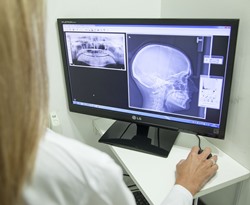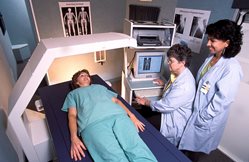Choosing a Radiology Technician School
 Congratulations on your decision to enroll in an x-ray tech school in order to become a radiologic technologist. But now that you have decided to enter the rewarding field of healthcare, how do you go about choosing the right school and program so that you will receive the proper training to become a skilled professional? And since most states do require that x-ray techs become licensed, depending on where you ultimately practice you may need preparation to pass a licensing exam. So it’s important that you research each of the schools you are considering so that you can compare each program. Many students start by looking for colleges or technical schools that are within commuting distance of their homes. Next, they compare tuition and often gravitate toward the lowest cost. But while location and cost should be taken into account, there are other important qualifiers as well. For example, you need to find out whether or not the schools are accredited, or if they sponsor internship programs. These questions and others you may want to ask the schools you are evaluating are provided later in this article. But first, let’s talk about what a radiology technician does and the credentials and training options that are available.
Congratulations on your decision to enroll in an x-ray tech school in order to become a radiologic technologist. But now that you have decided to enter the rewarding field of healthcare, how do you go about choosing the right school and program so that you will receive the proper training to become a skilled professional? And since most states do require that x-ray techs become licensed, depending on where you ultimately practice you may need preparation to pass a licensing exam. So it’s important that you research each of the schools you are considering so that you can compare each program. Many students start by looking for colleges or technical schools that are within commuting distance of their homes. Next, they compare tuition and often gravitate toward the lowest cost. But while location and cost should be taken into account, there are other important qualifiers as well. For example, you need to find out whether or not the schools are accredited, or if they sponsor internship programs. These questions and others you may want to ask the schools you are evaluating are provided later in this article. But first, let’s talk about what a radiology technician does and the credentials and training options that are available.
X-Ray Tech Job Description
 There are multiple professional titles for x-ray techs (technicians or technologists). They may also be called radiologic technologists, radiologic technicians, radiology technicians or radiographers. Regardless of the name, they all have the same primary job function, which is to use imaging machines to internally visualize patients for the purpose of diagnosis and treatment. Some radiologic technologists may also administer radiation therapy for the treatment of cancer. Some choose to practice as generalists, while others may choose a specialty, such as mammography. They can work in hospitals, clinics, private practices or outpatient diagnostic imaging centers. The imaging technologies that an X-Ray technologist may work with include:
There are multiple professional titles for x-ray techs (technicians or technologists). They may also be called radiologic technologists, radiologic technicians, radiology technicians or radiographers. Regardless of the name, they all have the same primary job function, which is to use imaging machines to internally visualize patients for the purpose of diagnosis and treatment. Some radiologic technologists may also administer radiation therapy for the treatment of cancer. Some choose to practice as generalists, while others may choose a specialty, such as mammography. They can work in hospitals, clinics, private practices or outpatient diagnostic imaging centers. The imaging technologies that an X-Ray technologist may work with include:
- Traditional and specialized X-Rays
- Computerized tomography (CT) or “CAT” scans
- Magnetic resonance imaging (MRI)
- Sonography or ultrasound
- Fluoroscopy
Radiographers must maintain their equipment and also regularly evaluate its performance and safety. They are also required to keep detailed records of each of their diagnostic procedures. As medical practitioners, they are held to a high professional standard and code of conduct.
X-Ray Technician Degrees
 The basic requirement for attending an x-ray tech school is to have earned a high school diploma or GED. Radiologic technologist students have the option to earn either an Associate Degree or a Bachelor’s Degree. An Associate Degree, which is the most common among technicians, generally takes 18 months to 2 years to complete depending on the program and course load. A Bachelor’s Degree will take longer at up to 4 years to complete and is more comprehensive in nature. Most students choose a degree major in Radiography, but there are other related majors that may be acceptable as well. One thing to keep in mind is that radiographer schools have a clinical training or lab component as part of their curriculum. It can often be satisfied by participating in an externship program which many schools sponsor through local hospitals and clinics in their area. Once you have graduated from one of the degree programs, you will need to comply with any licensing or certification requirements in {state} or the state you will be practicing in as applicable.
The basic requirement for attending an x-ray tech school is to have earned a high school diploma or GED. Radiologic technologist students have the option to earn either an Associate Degree or a Bachelor’s Degree. An Associate Degree, which is the most common among technicians, generally takes 18 months to 2 years to complete depending on the program and course load. A Bachelor’s Degree will take longer at up to 4 years to complete and is more comprehensive in nature. Most students choose a degree major in Radiography, but there are other related majors that may be acceptable as well. One thing to keep in mind is that radiographer schools have a clinical training or lab component as part of their curriculum. It can often be satisfied by participating in an externship program which many schools sponsor through local hospitals and clinics in their area. Once you have graduated from one of the degree programs, you will need to comply with any licensing or certification requirements in {state} or the state you will be practicing in as applicable.
Radiologic Technologist Licensing and Certification
Once you have graduated from an x-ray technician program, depending on the state where you will be practicing you may have to become licensed. Most states do require licensing, and their requirements vary so check with your state. Currently, all states that do require licensure will accept The American Registry of Radiologic Technologists (ARRT) certification exam for the purpose of licensing, but many offer other options for testing as well. Some states also require certification as part of the licensing process, otherwise it is optional. However, many {city} area employers prefer to hire radiology techs that are certified so it may enhance your career options to earn certification. ARRT’s certification program requires graduation from an approved program as well as a passing score on their comprehensive examination. ARRT also requires re-certification every two years, which can be satisfied with 24 credits of continuing education, or by passing an exam.
Online X-Ray Technologist Programs
 As part of any degree program, x-ray tech schools will have a clinical or lab component as part of their training. This is no different for online degree programs. So while you can still earn your degree online, a substantial portion of the training will be satisfied either in a school lab or in an internship off campus. Clinical training is often conducted in local hospitals, outpatient clinics or private practices in sponsorship with the colleges. But the online portion of the training can be accessed in the privacy of your {city} home. Students who continue working while earning their degree often find that the online style of learning is much more convenient with their busy schedules. Plus online schools are generally less expensive than traditional options. In addition to lower tuition, expenses for commuting and study materials may be reduced as well. But just be sure that the online school you select is accredited (more on the benefits of accreditation later). So if you are disciplined enough to learn with this less formalized type of training, then online classes may be the right option for you.
As part of any degree program, x-ray tech schools will have a clinical or lab component as part of their training. This is no different for online degree programs. So while you can still earn your degree online, a substantial portion of the training will be satisfied either in a school lab or in an internship off campus. Clinical training is often conducted in local hospitals, outpatient clinics or private practices in sponsorship with the colleges. But the online portion of the training can be accessed in the privacy of your {city} home. Students who continue working while earning their degree often find that the online style of learning is much more convenient with their busy schedules. Plus online schools are generally less expensive than traditional options. In addition to lower tuition, expenses for commuting and study materials may be reduced as well. But just be sure that the online school you select is accredited (more on the benefits of accreditation later). So if you are disciplined enough to learn with this less formalized type of training, then online classes may be the right option for you.
Questions to Ask Radiographer Colleges
Once you have decided on the type of degree that you would like to earn, you can start the process of finding and evaluating x-ray technician colleges. You will also need to decide if you want to attend classes online or commute to a nearby campus. If you opt for the latter, then obviously the location of the school will be important. The cost of tuition and ancillary expenses will be an important factor as well. But in addition to cost and location, what else should you consider when comparing schools. Well, you should find out if the schools are accredited, and if they sponsor internship or externship programs. So in order to find out some of these important details before you make your selection, we have compiled a list of questions that you should ask the schools you are considering.
Is the X-Ray Tech Program Accredited? The majority of x-ray technician colleges have earned accreditation on a local or national basis. However, it’s still important to confirm that preferably both the school and the program you enroll in are accredited. One of the most highly regarded accrediting organizations in the field of radiology is the Joint Review Committee on Education in Radiologic Technology (JRCERT). Programs receiving accreditation from the JRCERT have received a detailed evaluation of their instructors and course materials. If the school is online it may have also received accreditation from the Distance Education and Training Council, which focuses on online or distance learning. Each accrediting agency should be recognized by the U.S. Department of Education or the Council on Higher Education Accreditation. In addition to ensuring a quality education, accreditation may also be required to qualify for licensing and certification. Also, many employers in the {city} area will only hire graduates of accredited programs. And finally, student loans and financial aid is typically only available for accredited schools.
Do the Schools offer internship Programs? Internships are an ideal way for students to get practical experience outside of the theoretical teachings of a classroom. Most X-ray technician degrees require clinical training and internships are often part of the program. Ask the colleges you are considering if they sponsor internships and if they have relationships with area hospitals, clinics and labs. In addition to the valuable clinical experience, internships also help in establishing professional relationships within the local healthcare community. Sometimes they even lead to offers of employment upon graduation. They also look pretty good on a resume.
What are their Job Placement Rates? Once you have earned your radiologic technician degree, you will no doubt want start your new career right away and land a job. Finding a new position will be much easier if you have assistance from a successful job placement program. Ask the schools you are evaluating if they have a program and what their placement rates are. Also, ask how long on average it takes them to place students, and what the average starting salaries are. High and rapid placement rates, combined with good starting salaries are indications that the schools have large networks of potential employers as well as excellent reputations.
Where are they Located? The location of the radiology school is important if you have decided to commute from your home. Even if you enroll in an online school, you will still need to attend clinical training, either in an on campus lab or in an approved externship program. So if you attend classes online, be sure to find out what your clinical options are. If you decide to enroll in a school out of area or out of state, remember that there may be a higher tuition than for resident students. This is particularly true for state colleges or universities as well as community colleges.
What are the Class Sizes? You will want to receive as much one-on-one instruction as possible, which is not likely to be as available in larger classes. Ask the schools you are evaluating what their average ratios are for teachers compared to students. The larger the ratio (more students per teacher), the less personal attention you will likely receive. You can also request to sit in on some classes so you can monitor the interaction between students and teachers. Also, talk to some of the students and find out what their experiences have been. Speak with the instructors as well and find out what their teaching styles are and what you can expect in their classes.
Are Classes Available When You Need Them? Before choosing a school, confirm that the x-ray tech program offers classes that fit your hectic schedule. This is extremely important if you plan on working while earning your degree. If you can only attend classes at night or on weekends near your home, make sure that classes are offered at those times. Also, if you are planning on attending part-time, ask the schools you are considering if they offer that option. Finally, find out what the options are for making up classes missed due to work or other emergencies or commitments.
Learn How to Choose an X-Ray Technician School
Choose the Right X-Ray Tech Program
Choosing the right x-ray technician degree program is a critical first step toward beginning a rewarding new career providing diagnostic medical services to patients. As we have covered in this article, there are several questions that you should ask each school you are considering before making your final decision. This is equally true whether you participate in an online program or commute to classes on campus. By asking the right questions you can evaluate and compare each school so you can narrow down your options and make your final choice. And with the right training and your commitment to succeed, you can achieve your goal to practice as a radiologic technologist.
In the United States, these professionals are known as Radiologic Technologists. Formal training programs in radiography range in length that leads to a certificate, an associate or a bachelor’s degree. After primary training and licensure, continuing education is required to maintain licensure and certification with the ARRT, who sets the accepted national guidelines.
